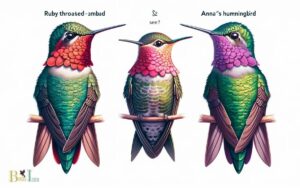How Fast Can a Ruby Throated Hummingbird Fly? 50 Miles!
A Ruby-throated Hummingbird can reach flying speeds of up to 25 to 30 miles per hour during normal flight and can increase this to about 50 miles per hour during courtship dives or when fleeing from predators.
The Ruby-throated Hummingbird (Archilochus colubris) is known for its incredible flight capabilities.
These birds have a rapid wing beat, which can range from about 50 to 60 beats per second in a hover, allowing them to fly not only forwards but also backwards, and even upside down momentarily.
Their speed is advantageous for feeding on nectar from flowers and for evading potential threats.
During migration, they are capable of flying long distances, including a non-stop 500-mile flight across the Gulf of Mexico.
The Ruby-throated Hummingbird’s speed and agility are not just for show; these traits are essential for their survival and reproductive success.
The incredible speed of the Ruby-throated Hummingbird is a testament to their specialized flight muscles and wing design, which allow for impressive and agile maneuvers in the air.

Key Takeaway
The Ruby-Throated Hummingbird: An Introduction
The Ruby-throated hummingbird is a small, migratory bird species found in North America. Known for its remarkable agility and vibrant coloring, these birds are a delight to observe.
They are the only hummingbird species that breeds in eastern North America and then migrates to Central America for the winter.
Their diet primarily consists of nectar from flowers, but they also consume insects and tree sap.
Despite their tiny size, these birds are resilient and possess remarkable flying abilities, making them a fascinating subject of study for ornithologists and bird enthusiasts alike.
Understanding the behavior and physical characteristics of the Ruby-throated hummingbird provides valuable insight into the intricate world of avian biology. Now, let’s delve into their physical characteristics and anatomy.
Physical Characteristics and Anatomy
Exhibiting remarkable agility and vibrant coloring, the Ruby-throated hummingbird’s physical characteristics and anatomy contribute to its exceptional flying abilities.
Delving into its anatomy further reveals the intricacies that enable this bird to achieve such impressive speeds.
This tiny bird possesses a streamlined body, allowing it to cut through the air with minimal resistance. Its wings, capable of beating up to 80 times per second, form a figure-eight pattern, generating lift on both the upstroke and downstroke.
These unique wing movements, coupled with a rapid heart rate and high metabolism, enable the Ruby-throated hummingbird to hover in mid-air and achieve speeds of up to 30 miles per hour.
Additionally, its skeletal structure is adapted to support the rapid wing movement required for its exceptional agility and speed.
Understanding these physical attributes provides insight into the hummingbird’s remarkable flying capabilities.
Flight Patterns and Techniques
Having explored the physical characteristics and anatomy of the Ruby-throated hummingbird, we can now delve into its flight patterns and techniques, which are intricately shaped by its unique physiology.
The flight of the Ruby-throated hummingbird is characterized by its agility, speed, and maneuverability.
These birds are capable of hovering in mid-air, flying backward, and even upside down for short distances.
Their wings beat in a figure-eight pattern, allowing them to move in all directions with precision.
Additionally, their rapid wingbeats, averaging around 53 beats per second during normal flight and up to 200 beats per second during courtship displays, enable them to achieve remarkable aerial acrobatics.
The Ruby-throated hummingbird’s flight techniques are a testament to its remarkable adaptation for feeding on nectar and catching small insects while in flight.
Speed and Agility in Flight
With remarkable agility, Ruby-throated hummingbirds navigate their environment at astonishing speeds, showcasing their unparalleled aerial prowess.
These tiny birds are capable of reaching impressive velocities, allowing them to dart through the air with remarkable precision.
Their exceptional speed and agility enable them to perform intricate aerial maneuvers, such as sudden changes in direction and rapid accelerations, which are essential for foraging and evading predators.
To truly appreciate the remarkable capabilities of these feathered marvels, consider the following table:
| Speed and Agility | Description | Emotional Response |
|---|---|---|
| Velocity | Astonishing speeds | Awe |
| Maneuverability | Intricate movements | Amazement |
| Precision | Rapid accelerations | Admiration |
| Agility | Sudden changes | Fascination |
| Acceleration | Swift movements | Wonder |
Understanding the speed and agility of Ruby-throated hummingbirds provides insight into their remarkable abilities, setting the stage for exploring the factors influencing their flight speed.
Factors Affecting Flight Speed
When considering the factors that affect a ruby-throated hummingbird’s flight speed, it is crucial to examine the bird’s wing size and shape, as these directly impact its aerodynamics.
Additionally, environmental conditions such as wind speed and direction can significantly influence the bird’s ability to maneuver and maintain a certain speed.
Lastly, the hummingbird’s metabolic rate plays a pivotal role in determining how fast it can fly, as it affects the bird’s energy expenditure during flight.
Wing Size and Shape
The wing size and shape of the Ruby Throated Hummingbird significantly influence its flight speed. With a wingspan of approximately 4 inches, these birds possess relatively short and rounded wings.
This unique wing morphology allows for exceptional agility, crucial for their hovering and rapid maneuvering during flight.
The rapid wing beats, averaging around 53 beats per second during normal flight and increasing to 200 beats per second during courtship displays, are facilitated by the hummingbird’s small, elliptical wings.
This shape reduces air resistance and enables swift acceleration. Moreover, the ratio of wing size to body mass directly impacts the bird’s capacity for sustained flight.
The Ruby Throated Hummingbird has evolved to optimize its wing characteristics for unparalleled aerial abilities, making it one of the fastest and most agile birds in the animal kingdom.
Environmental Conditions
At what altitude and under which atmospheric conditions can a Ruby Throated Hummingbird achieve its maximum flight speed?
The flight speed of a Ruby Throated Hummingbird can be influenced by various environmental factors such as altitude, temperature, wind, and air density.
At higher altitudes, where the air density is lower, the hummingbird may experience less air resistance, potentially allowing it to achieve higher speeds.
Additionally, warmer temperatures can result in reduced air density, potentially aiding the bird in achieving faster flight. However, strong winds may pose challenges for the hummingbird, affecting its ability to reach peak speeds.
| Environmental Factor | Effect on Flight Speed |
|---|---|
| Altitude | Potential decrease in air resistance, aiding faster flight |
| Temperature | Warmer temperatures may decrease air density, potentially aiding faster flight |
| Wind | Strong winds may hinder the hummingbird’s ability to achieve peak speeds |
Metabolic Rate Influence
In relation to the flight speed of a Ruby Throated Hummingbird, the influence of metabolic rate becomes apparent during sustained periods of flight.
Several factors affecting flight speed are directly related to the bird’s metabolic rate:
- Energy Production: The rate at which the hummingbird’s body produces energy affects its ability to sustain high-speed flight.
- Oxygen Consumption: A higher metabolic rate increases the bird’s oxygen consumption, influencing its endurance and speed.
- Muscle Efficiency: Metabolic rate impacts the efficiency of the hummingbird’s flight muscles, affecting its propulsion and speed.
- Heat Regulation: Metabolic processes generate heat, and the hummingbird’s ability to regulate this heat production influences its flight speed and endurance.
Understanding these metabolic influences is crucial for comprehending the remarkable speed and agility of the Ruby Throated Hummingbird during sustained flight.
Comparison to Other Bird Species
When comparing the flight speed of the Ruby Throated Hummingbird to other bird species, it becomes evident that its remarkable velocity sets it apart in the avian world.
While the Ruby Throated Hummingbird can reach impressive speeds of up to 60 miles per hour during its migratory flights, it is essential to note that this is an exceptional feat even among birds known for their agility and speed.
For instance, the Peregrine Falcon, known for its breathtaking hunting dives, reaches speeds of 240 miles per hour, making it the fastest bird in level flight.
However, the hummingbird’s ability to hover and move swiftly in any direction surpasses that of most bird species. This unique characteristic makes the Ruby Throated Hummingbird a fascinating subject of study in the avian world.
Understanding these unique capabilities is crucial for conservation efforts and future outlook.
Conservation Efforts and Future Outlook
Comparison to other bird species demonstrates the exceptional speed and agility of the Ruby Throated Hummingbird, highlighting the importance of conservation efforts and the need to understand its unique capabilities for the future.
Conservation of the Ruby Throated Hummingbird is crucial for maintaining biodiversity and ecosystem balance. Efforts to protect its natural habitats, such as tropical and subtropical forests, are essential.
Understanding their migratory patterns and breeding behaviors can aid in targeted conservation strategies.
Educating the public about the significance of preserving these tiny yet remarkable birds is also vital for their future survival.
By supporting research initiatives and implementing conservation measures, we can ensure the continued existence of the Ruby Throated Hummingbird for generations to come.
- Protect natural habitats
- Understand migratory patterns and breeding behaviors
- Educate the public
- Support research and conservation measures
Conclusion
The ruby-throated hummingbird is a remarkable bird known for its agility and speed in flight. Despite its small size, it can reach impressive speeds and maneuver with great agility.
While some may argue that the bird’s flight speed is not significant compared to larger bird species, it is important to recognize the incredible adaptations and abilities of this tiny bird, highlighting the diversity and complexity of the natural world.






